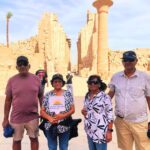For centuries, the term “Egyptian tomb” has conjured images of vast deserts, grand pyramids, hidden treasures, and stories of an ancient civilization that thrived along the Nile River. Egyptian tombs, remarkable for their architectural brilliance and symbolic depth, continue to fascinate archaeologists, historians, and enthusiasts alike. These eternal resting places reveal not only the artistic and technological achievements of ancient Egypt but also their profound spiritual beliefs about life, death, and the afterlife.
In this blog, we’ll delve into the history, construction, cultural significance, and modern discoveries of Egyptian tombs.
The Historical Evolution of Egyptian Tombs
The concept of tombs in ancient Egypt dates back thousands of years and evolved significantly over time. Initially, tombs were simple pits dug in the sand. However, as the civilization grew more advanced, so did the complexity of their burial practices.
- Early Dynastic Period (c. 3100–2686 BCE):
During this era, tombs were typically mastabas, flat-roofed rectangular structures made from mudbrick. Mastabas served as the precursor to the more elaborate burial chambers seen in later periods. - Old Kingdom (c. 2686–2181 BCE):
This period saw the construction of pyramids, the most iconic Egyptian tombs. The Great Pyramid of Giza, built for Pharaoh Khufu, remains one of the Seven Wonders of the Ancient World. Pyramids reflected both the technological prowess and the divine authority of the pharaohs. - Middle Kingdom (c. 2055–1650 BCE):
Tomb construction moved away from pyramids during this time, focusing instead on rock-cut tombs in cliff faces, particularly in areas like Beni Hasan. This shift reflected economic and political changes in Egyptian society. - New Kingdom (c. 1550–1070 BCE):
The Valley of the Kings became the primary burial site for pharaohs and nobles. These tombs were hidden underground, richly decorated, and protected by traps and curses to deter grave robbers. - Later Periods (c. 664 BCE–30 BCE):
Tomb construction became simpler and less grandiose, reflecting the waning power of Egypt’s rulers. Despite this, the reverence for the afterlife remained a central aspect of Egyptian culture.
Why Were Egyptian Tombs So Significant?
Egyptian tombs were more than burial places—they were gateways to eternity. The Egyptians believed that life on Earth was just a brief stage in an eternal journey, and the tomb was designed to ensure the deceased’s safe passage to the afterlife.
- Religious Beliefs:
Central to Egyptian religion was the concept of the Ka, Ba, and Akh—aspects of the soul that required a properly prepared tomb, along with food, offerings, and spells, to thrive in the afterlife. - Preservation of the Body:
Mummification, a hallmark of Egyptian burial practices, was essential to preserve the body for the afterlife. Tombs were carefully sealed to protect mummies from environmental elements and thieves. - Symbolism:
Tombs were richly decorated with scenes depicting the deceased’s life, religious rituals, and texts from the Book of the Dead, a guide to navigating the challenges of the afterlife. - Treasures and Offerings:
The inclusion of jewelry, furniture, food, and even games reflected the belief that the deceased would need these items in the afterlife.
Architectural Marvels: How Were Egyptian Tombs Built?
The construction of Egyptian tombs is a testament to the ingenuity of ancient engineers and laborers. From the massive pyramids to the intricate underground chambers, building these structures required meticulous planning and advanced techniques.
- Planning and Design:
Egyptian tombs were often designed to align with celestial bodies. For example, the pyramids at Giza are oriented to the cardinal points of the compass, with precision that still amazes modern scientists. - Labor Force:
Contrary to popular belief, the builders of these tombs were not slaves but skilled workers and craftsmen who lived in nearby villages and were well-fed and cared for. - Materials and Tools:
Tombs were constructed using locally sourced materials like limestone, granite, and sandstone. Workers employed copper tools, ramps, and sledges to carve and transport massive stone blocks. - Decoration:
After the tomb was built, artisans painted walls and carved intricate hieroglyphs depicting religious texts, magical spells, and scenes of daily life. Vibrant colors, often derived from natural minerals, were used to bring these images to life.
Famous Egyptian Tombs
- The Great Pyramid of Giza:
The most famous Egyptian tomb, this monumental structure was built for Pharaoh Khufu around 2560 BCE. It once stood at 146 meters and remains a marvel of ancient engineering. - King Tutankhamun’s Tomb:
Discovered in 1922 by Howard Carter, this tomb in the Valley of the Kings contained a wealth of treasures and provided invaluable insights into ancient Egyptian burial practices. - Hatshepsut’s Mortuary Temple:
This magnificent structure in Deir el-Bahari was built for one of Egypt’s few female pharaohs. Its unique design blends natural and architectural elements seamlessly. - Ramses II’s Tomb:
Ramses II, one of Egypt’s most powerful rulers, was buried in a richly adorned tomb in the Valley of the Kings. His legacy as a builder is unmatched in Egyptian history.
Egyptian Tomb Discoveries in Modern Times
The fascination with Egyptian tombs has fueled countless archaeological expeditions, many of which have unearthed incredible artifacts and mysteries.
- The Discovery of King Tut’s Tomb:
The untouched treasures of King Tutankhamun’s tomb offered a glimpse into the opulence of ancient Egypt and sparked a global fascination with Egyptology. - Recent Finds in Saqqara:
In 2020, archaeologists uncovered a series of well-preserved wooden coffins in Saqqara, dating back to the Late Period. These finds highlight how much remains hidden beneath the sands. - Digital Advances:
Modern technologies, such as ground-penetrating radar and 3D imaging, have revolutionized the study of Egyptian tombs, allowing researchers to explore hidden chambers without disturbing them.
Egyptian Tombs in Popular Culture
Egyptian tombs have inspired countless books, movies, and games, perpetuating their mystique. From the “Mummy” franchise to the Assassin’s Creed: Origins game, these resting places continue to capture the imagination of audiences worldwide.
The Enduring Legacy of Egyptian Tombs
Egyptian tombs are more than ancient relics; they are windows into the lives, beliefs, and artistry of one of the world’s most remarkable civilizations. They remind us of humanity’s universal desire to understand and prepare for what lies beyond death.
As archaeologists continue to uncover new secrets buried beneath the sands of Egypt, the story of the Egyptian tomb is far from over. Whether you’re a history buff or a casual enthusiast, these timeless monuments offer a fascinating journey into the heart of ancient Egypt.
So the next time you think of an Egyptian tomb, remember that it’s not just a burial site but a testament to the ingenuity, spirituality, and enduring legacy of an extraordinary civilization.




